The Interplay of Advance Wars
 Saturday, May 9, 2009 at 12:27PM
Saturday, May 9, 2009 at 12:27PM In Chess, a wide variety of tactics are possible because of the limitations of time (turn based), variety of piece movement, limitation of piece movement (can generally only move one piece per turn), and space (grid board). Despite a very different core design, Advance Wars (AW) supports the same kind of tactics and maneuvers because units have a range of interactions and dynamic effects. Instead of every piece being able to capture any other piece in one move like in Chess, in AW pieces can do anywhere from 0-100+% damage to each other. When attacking with direct attacking units, the attacking and defending pieces are positioned side by side so that if one piece destroys the other, an empty space is created. This is different from how pieces capture other pieces in Chess by moving into their square. The terrain in AW not only affects a sea or ground unit's defense, but it also affects each units ability to move through that position according to their movement type. For example, tires don't move well at all through the woods and only foot soldiers and aircraft can move over mountains.
Mechanical Counters
The mechanical counters (core/basic interplay) in Advance Wars are all relatively simple. Instead of supporting a triangle based interplay system, Advance Wars features an intricate web of units interactions. See the damage chart here. However, this chart doesn't need to be memorized. You can check how much damage your attacks will do before you make any move if you need to. But AW isn't all about attacking. Factors like how much ammo, fuel, movement type, movement speed (squares per turn), how much each unit costs to produce, as well as the actual map layout affect the usefulness and the potential of each unit to a large degree. To generalize, there are only a few mechanical counters in the game.
- Attack with your unit(s). (Preventative/Quasi Counter)
- Counter attack with your unit(s). (Reactionary/Quasi Counter)
- Build a specific unit(s) to counter a unit the opponents has, will have, or can have. (Reactionary/Preventative Counter)
- For indirect attackers like the Artillery, Rockets, and Missiles, you can move inside of their range so they can't attack you without moving. Because these units can't move and shoot in the same turn, these units have an obvious functional blind spot. (Natural Counter)
- Hide a unit in the fog of war so that enemies are frozen if they try to move through that position. (Special Case Counter)
It's difficult to talk about the counters in Advance Wars without looking at specific examples because the gameplay is made up of several layers. To win, you can either capture the opponent's HQ or destroy all of the opponent's units. To gain an advantage, you can either amass funds to buy more powerful units or you can try and destroy all of the opponent's powerful units. A powerful unit is only as good as its ability to move, attack, and defend. If the map/terrain isn't suitable for a specific unit to carry out those actions, then it's useless. In a turn based game where each player can move all of their units each turn, delaying an enemy unit's movement/progress even by a turn can prevent it from reaching a position where it's needed. For these reasons, a single action/mechanic is wrapped in an intricate and dynamic interplay system where players fight for position and time in a number of ways simultaneously.
The following are series of Chess tactics that have parallels in common Advance Wars gameplay. The AW examples below are simplified and taken out of the context of what can be found in a normal/balanced map. All quotes are taken from the Wikipedia pages on Chess tactics.
a fork is a tactic that uses one piece to attack two or more of the opponent's pieces at the same time, hoping to achieve material gain (by capturing one of the opponent's pieces) because the opponent can only counter one of the two (or more) threats.

The Rocket in the example above has forked two blue Mech units. Because the Mech units can't run away outside of the Rocket's range, they're forced to move toward the Rocket. After they move forward, the farthest unit is hit by the Rocket. Normally, Rockets are supported by weaker/guarding units in front to keep enemy units within range for as long as possible.
In this example, the fork is created because the Mech units can only move 2 squares per turn. Forks in AW often occur on terrain that limits movement options like mountains, woods, rivers, or narrow bridges.
a pin is a situation brought on by an attacking piece in which a defending piece cannot move without exposing a more valuable defending piece on its other side to capture by the attacking piece. "To pin" refers to the action of the attacking piece inducing the pin, and the defending piece so restricted is described as pinned.
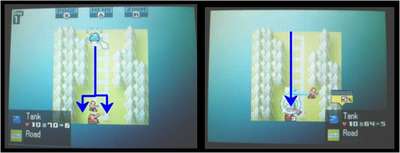
The Artillery at the bottom of the image is being protected by the lone Infantry. The blue Tank can only move 7 squares, which makes the red army's formation perfect for keeping the Artillery (the more expensive unit) safe for 1 additional turn. The image to the right shows what would happen if Infantry moved out of the way. The Tank would attack the artillery damaging it to 3 HP.
a skewer (or thrust) is an attack upon two pieces in a line and is similar to a pin. In fact, a skewer is sometimes described as a "reverse pin"; the difference is that in a skewer, the more valuable piece is in front of the piece of lesser or equal value.

In the example above, the B.Copter must must out of the way of the incoming Anti Air gunner if it doesn't want to be destroyed in one hit. When the B.Copter moves, it exposes the less expensive unit which will most likely be destroyed the next turn.
It describes a situation where one player is put at a disadvantage because he has to make a move – the player would prefer to pass and make no move. The fact that the player must make a move means that his position will be significantly weaker than the hypothetical one in which it is his opponent's turn to move.

Finding a parallel to this tactic in AW is difficult because each player technically doesn't have to make any moves on their turn. The closest examples I can think of are when you trap a expensive enemy unit (especially with cheap units) and force them to fight their way out thus wasting their ammo. Another example is when you either retreat or wait out a sea or air unit until they run dangerously low on fuel. Unlike ground units, sea and air units explode when their fuel runs out. So, a player wishing to preserve their investment may be "forced" to make a move and retreat from a really advantageous situation. One final and rare example is when you purposely damage an enemy unit on your turn that's parked on a property that will heal it at the beginning of the next turn. When that unit is automatically healed, money is taken away from your opponent's funds. In this way, you can force the opponent to use their cash on something they didn't plan/expect when they would rather just have that unit destroyed.
Because it's very difficult to show the decay of ammo and fuel in an image, the simplified scenario above will have to do.
The zwischenzug (German for "intermediate move", is a chess tactic in which a player, instead of playing the expected move (commonly a recapture of a piece that the opponent has just captured) first interpolates another move, posing an immediate threat that the opponent must answer, then plays the expected move.
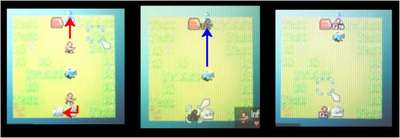
Above, two infantry units move away from each other to capture property. Normally in a scenario like this, the blue B.Copter could make quick work of red's units. However, the red at the top has started capturing blue's HQ essentially putting blue into check. Because the blue B.Copter must respond, the infantry at the bottom is free to capture the factory first before launching a missile from the silo just to the right of the factory. Because the blue B.Copter was busy "getting out of check" the bottom Infantry was free to capture the factory before using the silo against the B.Copter.
Another example of intermezzo is when an Infantry, Mech, or Bike unit is about to finish capturing a property, but it attacks a nearby enemy unit first before finishing off the capture on the next turn. If the nearby enemy unit is another capturing foot soldier, a indirect attacking unit that can't fire back, or a nearly dead unit, executing the intermediate attacking move can give you strong positional advantages. This strategy is especially effective when your Infantry/Mech/or Bike unit takes 0-2 points of counter strike damage because after that units finishes capturing the property (if it's a factory or a city) they will be healed at the beginning of their next free turn anyway.
A battery in chess is a formation that consists of two or more pieces on the same rank, file, or diagonal. It is a tactic involved in planning a series of captures to remove the protection of the opponent's king, or to simply gain in the exchanges.
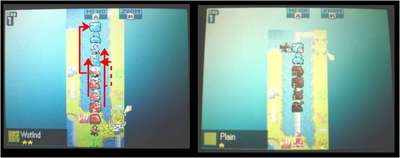
Although batteries in AW aren't limited in how the pieces are arranged in space (rank, file, diagonal), the concept is the same; punching a hole in the opponent's defense. Because the units in AW can all move in a single turn, attacking all at once is common. However, because units can counter attack and attack over other pieces indirectly, the defensive formations in AW can still be very complex and difficult to punch through. Add in restricting level formations like bridges and it's easy to see how varied and complex batteries are in AW.
In the example above, the blue army has set up a formation of a Md Tank, Missiles, Infantry, and Anti Air from top to bottom. It's red's turn to move. By attacking the blue units in such a way so that their units are destroyed, spaces open up for more of red's units to move up into and attack. By arranging the units in red's battery specifically to counter blue's defensive formation/wall both offensively (to destroy move units) and defensive (minimizing possible damage taken on next turn) it's possible to turn the restrictions that make up the opponent's wall into their weakness. In the image to the right, red's B.Copter is safe from Missile fire and has damaged blue's Md.Tank. Now blue is in a terrible position. The most damage blue can cause at this point is attacking the B.Copter or moving the Missile unit back and attacking the Rig. Both are pretty useless options for blue.
Undermining (also known as Removal of the Guard) is a chess tactic in which a defensive piece is captured, leaving one of the opponent's pieces undefended or underdefended.
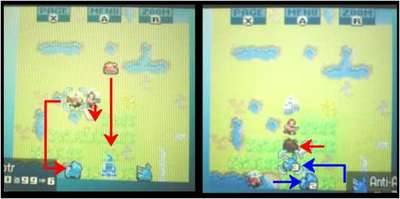
The Rocket is a popular unit for setting up strong defenses because of its large range and high power. To balance these extreme advantages, the Rockets can't fire back on units when attacked, they can't move and shoot in the same turn, they can be easily damaged by just about any unit, and they have a large 12 square inner range that they can't attack in. For these reasons, it's important to set up your Rockets in advance and block incoming attacks to maximize their effectiveness. However, if the enemy punches through your walls/blocks (perhaps with a battery) and they get to your Rocket, your entire defense can be compromised. Don't forget, Rockets are fairly expensive.
In the example above, the blue Rocket is attacked by the red B.Copter. Because the Rocket was weakened, the red Infantry and Tank move up without fear of being severely damaged. With blue's next turn, there's nothing it can do to cause any serious damage because the Anti Air unit can't move through all the woods squares quickly enough to reach the Infantry or the B.Copter.
Overloading is a chess tactic in which a defensive piece is given an additional assignment which it cannot complete without abandoning its original assignment.
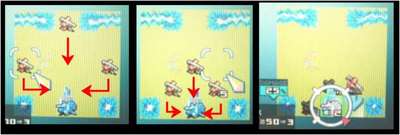
Overloading indirect attackers in AW is a very common way of punching through their range and power. Even with a powerful indirect attacking unit like the AntiTank that's parked on its own HQ for the added defensive bonus and healing bonus, there's only so much the unit is capable of fighting.
In the example above, the blue AntiTank is overloaded with 3 Mech units. Even though the Mechs can't reach the AntiTank on their first move and one of them takes a hit, their combined forces are still too much for the AntiTank. Altogether the Mech units cost 7500 funds while the AntiTank costs 11000 so this strategy for overloading an AntiTank is also economically sound.
Interference occurs when the line between an attacked piece and its defender is interrupted by sacrificially interposing a piece.
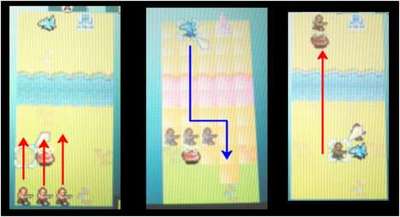
One of the best parts about running interference in AW is that the piece that blocks the attacking piece doesn't necessarily have to be sacrificed. In the example above, the Jet's only goal is to shoot down red's T.Copter (a unit that can carry an Infantry/Mech unit over water). In AW, Jets are extremely powerful and mobile, but they can only attack other flying units. All red has to do to block the Jet is move up the 3 Infantry grounds units. As it turns out, this strategy is just enough to block the Jet from attacking red's T.Copter by one square. On red's next turn, an Infantry hopped into the T.Copter and was safely delivered to the other side of the divide.
For the reasons above, the Advance Wars series proves to be one of the greatest turn based strategy video games of all time. From my experience, games like Fire Emblem and Final Fantasy Tactics don't even come close to the depth of Advance Wars, which is a shame considering that those other two games have so many more complexities.
If I have time, I'll show case these tactics in an actual Adavance Wars battle.
 Advance Wars,
Advance Wars,  Chess,
Chess,  Strategy,
Strategy,  Turn-based in
Turn-based in  Depth & Complexity,
Depth & Complexity,  Interplay |
Interplay |  Permalink |
Permalink |  Print Article
Print Article 
